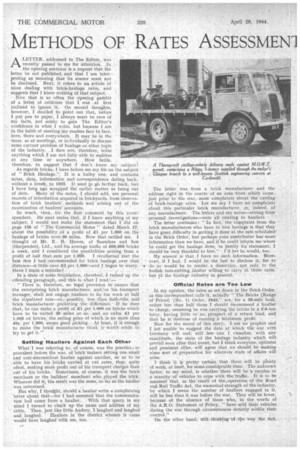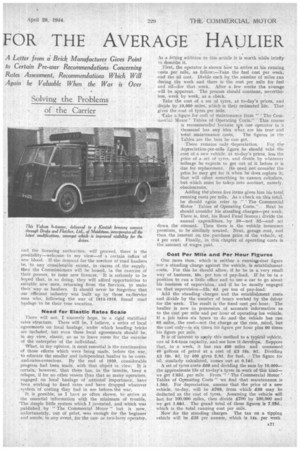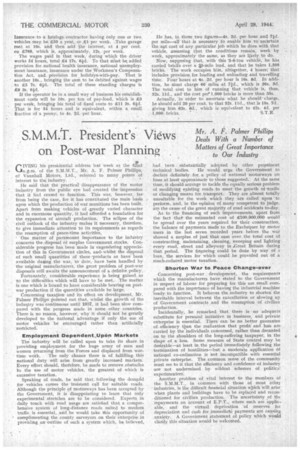METHODS OF RATES ASSESSMEN1 FOR THE AVERAGE HAULIER
Page 22

Page 23

Page 24

If you've noticed an error in this article please click here to report it so we can fix it.
A Letter from a' Brick Manufacturer Gives Point to Certain Pre-war Recommendations Concerning Rates Assessment, Recommendations Which Will Again be Valuable When the War is Over
Solving the Problems of the Carrier
jk LETTER, addressed to The Editor, was
recently passed to me for attention. _In .
the opening sentence is a request that the • letter be not published, and that I am inter-' . preting as meaning that its source must not be disclosed. Next, it refers-to an article:Of mine dealing with brick-haulage rates,and suggests that I know nothing of that subject.
Now that is so often the Opening 'gatiabit of a letter of criticism that I was at first inclined to ignore it. On second thoughts, however. I decided to point out that, before I put pen to paper. I always must be sure of my facts, not solely to gain The Editor's confidence in what I write, but because I am in the habit of meeting my readers face to face, here, there,and everywhere. It may be in the mass, as at meetings, or individually to discusssome current problem of haulage or other tdpic of the industry. _I dare not, therefore, write anything which .1 am not:fully able to enddrse at any time or anywhere. How futile, therefore, to suggest that 1 don't . know my subject!
As regards bricks. I have before me my file on the subject of " Brick Haulage.". It is a bulky one,and contains notes, data; information and correspondence dating back, without a break, to 1933. It used to go farther back, but
have long ago scrapped the earlier matter as being out of date, Many of the notes, I should add, are personal records of information acquired in brickyards; front observa.. tion of brick hauliefs'. methods and arising out of the examination of hauliers' accounts. .
So much, then, for the first comment by this corre: spondent. He next states that, if I knew anything of my subject, I would not make the statement that I did on page 126 of " The Commercial Motor " • dated March 17, about the possibility .of a profit of £1 per 1,000 on. the haulage of bricks over 30 miles. Now that rattled me. I thought of Mr. E. B. Howes, of Saunders and Son (Harpenden), Ltd., and his average traffic of 500,000 bricks .a week,' and I considered the possibilities arising from a
profit of half that. sum per .1,000. I recollected that the best rate I had •recommended for brick haulage'. over that .distance--alittle over £2 per 1-,000-=and I began to worry.
,Have I made a mista.'ke? . • •. . • • Irf'a state of some trepidation, therefore I turned up the
• offending-paragraph,. and this is what I read:'— There is, therefore, no legal provision to ensure that the enterprising brick manufacturer, and/or his transport manager,shall not eng-age .hauliers to do the work at half the stipulated rate—or, possibly, less than lialf=the said brick manufacturer Pocketing the difference. • If he does that, he can make .a profit of £1 per 1,000 ori bricks Which have to he Carted 30 miles or so, and an extra. £1 per 1,000 on bricks: the selling price of which is no more than 49s. per 1;000, seems good picking. . At least, it is enough to make -the brick manufacturer think it worth while to. try to. get it."
'Setting Hauliers Against Each Other
What-I was referring to., of course, was the practice, so prevalent .before the war, of brick 'makers setting one small and cost-unconscious haulier against another, so as'to be able . to have ids bricks carried at cut rates; thus, quite often, making more profit out Of his transport charges thah out of his bricks. Sometimes, of course, it was the brick merchant or the builders' merchant who played the trick. Whoever did it, the result was the same, so far as the haulier Was concerned.
But why, I thotight, should a haulier write a coMplaining letter about that—for I had assumed that the conimunication had come from a haulier.. With that query in my Mind I turned to check up the name and address of my critic. Then, just like little Audrey, I laughed and laughed and laughed-. Hauliers in the district whence it came would. have laughed. With me, Ado.
The letter was from a brick manufacturer and the address right in the centre of an area from whieh came, just priorto the war,. most complaints about the cuttling of brick-haulage rates. Let me say I have no complaints abotit this particular brick manufacturer, or, indeed, of any manufacturer: The letters and my notes—arising frOin personal • investigations—were all relating to hauliers.
The letter contimies: " In fact, the complaint from the brick manufacturerswho have to hire haulage is that they have great difficulty in getting it done at the rate scheduled' in the Brick Order,but perhaps your contributor has more information than we have, and if he could inform me 'where he could get the haulage done, to justify his statement, I
should-be very thankful to him." bet he.would, too. My. answer. is that.I have no such information. Moreover; .if I had, I would be the last to disclose it, for to
• do so would be to render a •disservice, not only to the foolish rate-cutting.lmulier willing to carry at thOse rateS, but ta the haulage industry in general. "
. Official Rates are Too Low
In my Opinion; -th,e rates as set. down in the Brick Order, as this Correspondent-calls it, actually " The Bricks (Range of Prices) .(No. 1) Order, 1943," are, for a 30-mile haul, rather less than half those I should recommend a haulier to charge,, assuming he was carrying the 'bricks in a 5-6-ton. lorry, having little of.no prospect of a return load, and that he is desirous of earning a minimum profit. ..
Now for the mural of this story. I. amno prophet and I ani unable to suggest the date at which the war with Gerinany will 'end; still less can I visualize; with any exactitude, the state of the haulage industry which Will • prevail soon after that event, but I think everyone, optimist and pessimist alike, will agree that we should bemaking .same sort of preparation 'for whatever state of affaire will arise.
think it is pretty certain that there will be plenty of work, at least, for some considprable time. The unknown factor, to my mind, is whether there will be k surplus or a scarcity of vehicles to cope with the traffic. It is to be assumed that, as the`result of the,operation of the Road awl Rail Traffic Act, the numerical-strength of the industry, by which I mean the number of hauliers engaged in it, will be less than it was before the war. They will be fewer, because of the absence of those who, in the words of the A.R.O. Statement of Policy, "'havesold their vehicles during the war through circurnstances entirely within their
control." ' •
On the other band; Still-thinking-of -way the 'Act,• arid the licensing authorities, will proeeed, there is the possibility—welcome in my view—of a certain influx of new blood. If the demand for. the 'services of road hauliers be, to any considerable extent, in excess of the supply, then the Commissioners will be bound, in the exercise of their powers, to issue new licences. It is seriously to be hoped that, in so doing, they will afford opportunities to suitable new men, returning from the Service's, to make their' way as hauliers. It should never be forgot-ten that our efficient industry was built up by those ex-Service men who, following the war of 1914-1918, found road haulage to be their true vocation.
Need for Elastic Rates Scale
There will not, I sincerely hope, be a rigid stabilized rates -structure. There will be, I believe, a series of local agreements on local haulage, under which heading bricks are included, but even these local agreements should he. in my view, elastic, so as to leave room for the exercise of the enterprise of the individual.
What, in my opinion, is most essential is the continuation of those efforts which were being made, before the. war, to educate the smaller and independent haulier to be costsj and-rates-conscious. By the .end of 1939, considerable progress had been made, with that objeet in view. It IS certain, however, that there has, in the interim, been a relapse, if for no other reason than that so, many operators, engaged on local haulage of 'national importance,. have been working to fixed rates and have dropped whatever system_ of costing they had in use before., the war.
It is possible, as I have so often shown, to. arrive at the essential information with the minimum of trouble. The simple little _system which I invented, and which was published by "The Commercial Motor " but is now, unfortunately, out of print, was enough for the 'beginner and ample, in--any event, for the oneor two-lorry operator,
As a fitting addition to this article it is worth while briefly to describe it
First, the operator is shown how to arrive at his running costs per mile, as follow:—Take the fuel cost per week, and the oil cost. Divide each by the number of miles run during the week and there is the cost per mile for fuel and oil—for that week. After a few weeks the average will be apparent. The process should continue, nevertheless, -week by week, as a check.
Take the cost of a set of tyres, at to-day's prices, and divide by 10,000 miles, which is their estimated life. That gives the cost of tyres per mile.
'Take a figare for cogt of maintenance from " ' The Commercial Motor ' Tables of Operating Costs." This course is recommended because not one operator in •a thousand has any idea what are his true and total maintenance costs. The figures in the Tables are the best he can get, There remains only 'depreciation. For the depreciation-per-mile figure he should take the cost of a new vehicle, at to-day's prices, less the price of a set of tyres, and divide by whatever mileage he expects to get out of it before it is due for replacement. fie need not consider the price he may get for it when he does replace it; that will offset something he cannot calculate, but which must be taken into account, namely, obsolescence.
Adding the-above five items gives him his total. running costs per mile. As a check on this total, he should again refer to " ' The Commercial Motor' Tables of Operating Costs." Next he should consider his standing charges—per week. There is, first, his Road Fund licence ; divide the annual expenditure_ by 50—not 52—and set down the amount. Then there is the vehicle insurance premium, to be similarly treated. Next, garage rent, and then the interest on the purchase price of the vehicle, at 4 per cent. Finally, in this chapter of operating costs is the amount of wages paid.
Cost Per Mile and Per Hour Figures One more item, which is neither a runnliag-dost figure nor a standing charge against the vehicle, is establishment costs. For this he should allow, if he be in a very small way of business, Ws. per ton of pay-load. If he be in a position to run a little office and to use a car to go about his business of supervision, arid if he be mostly engaged on that supervision-12s. 6d. per ton of pay-load.
Add the standing charges and the establishment costs and divide by the number of hours worked by the driver for the week. The result is the fixed cost pef, hour: The haulier is now in possession of accurate information as to the cost per mile and per hour of operating his vehicle. If a job takes six hours to do and the vehicle has run 60 miles, the cost—not the charge or the rate, .mind, but the cost only—is six times his figure per hour plus 60 times his figure per It is of interest to apply this method to a typical vehicle, one of 5-6-tons capacity, and see how it develops. Suppose that, in a week, it has run 400 miles and consumed 40 gallons of petrol at a cost of 23 16s. 8d. Dividing 23 16s, 8d. by 400 gives 2.3d. for fuel. The figure for oil, similarly calculated, comes out at 0.14d.
A set of tyres costs £68 and dividing the sum by 10.000-,--. the approximate life of to-day's tyres in work of-this kind— we get 163d. per mile From " ' The Commercial Motor ' Tables of Operating Costs" we find that maintenance is 1.50d. For depreciation. assume that the price of a new vehicle, to-day, will be £768, from which £68 may he dediwted as the cost of tyres. Assuming the vehicle will last for 100,000 miles, then divide £700 by 100,000 and we get 1.68d.. The grand total of these figures is 7.25d.,
which is the total running cost per mile. , Now for the standing 'charges. The tax on a tipping vehicle will be £35 per annum, which is 14s. per week.
Insurance to a haulage contractor having only one or two vehicles may be £50 a year, or. £1 per week. Take garage rent at 10s. and then add he interest, at 4 per cent. on £768, which is, approximately, 12s, per week.
The wages paid in that week, during which the driver works 54 hours, total £4 17s. so. To that mint be added provision for .national health insurance, national unemployment insurance, insurance under the Workmen's Compensation Act, and provision for holidays-with-pay. That is another 10s., bringing the sum to be debited against wages to £5 7s. 60. The total of these standing charges is E8 3s. 6icl.
If the operator be in a small way of business his establishment costs will be 10s. per ton of pay-load, which is £3 per week, bringing his total of fixed costs to £11 3s. 60. That is for 54 hours and is equivalent, within a small
fraction of a penny, to 4s. 2d. per hour. He has, in those two figures-4s. 2d, per hour and 7id. per mile—all that is necessary to enable him to ascertain the, net cost of any particular job which he does with that vehicle, assuming that the conditions remain, week by week, approximately the same, as they are likely to do. , Now, supposing that, with this '5-6-ton vehicle, he has carried brias over a ap-mile lead, and that he takes 1,500 bricks. The work occupies him, altogether, 4 hours; that includes provision for loading and unloading and travelling time. Four hours at 4s. 2d. per hour is 16s. 8d. In addition, he niust charge 60 miles at 71d., 'which is 36s. Si]. The total cost to him of running that vehicle is, thus, 52s. 11d., and the cost pe?1,000 bricks is more than 35s.
Actually, in order to ascertain what he should' charge, he should add 20 per cent, to that 52s. 1 ld., that is 10s. 7d.. giving him 63s. 6d.. which is equivalent to 42s. 4d. per 1,000, bricks. S.T.R.




















































